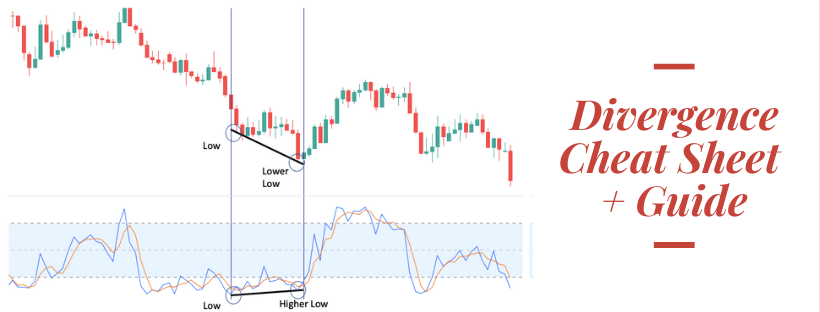So, you want to trade divergences. Becoming a divergence trader can be fun—not to mention allow you to start making money from your trading.
But divergence trading isn’t easy. It’s far easier to quit than to finish.
You’ll be tempted to give up trading divergences when you don’t understand them, when you run into losses, or when you have a hard time finding divergences on the chart.
But what if you knew exactly:
- What divergences are,
- How to find them easily,
- And how to trade them?
You can learn divergences—and more quickly than you might think, as these days you have access to more tools than ever.
First and foremost, download our divergence cheat sheet! It’s a free divergence PDF made exclusively to get you started with divergence trading as soon as possible.
Then read this guide from top to bottom. We’ll go through divergences in depth, so that you understand the concept completely before risking real money.
Here are the key points:
- What Is Divergence?
- Regular Divergences and Hidden Divergences
- How to Find Divergences Easily
- Divergence Cheat Sheet Table
- How Does Divergence Work? – A Closer Look at Divergences
- How to Trade Divergences
- Advanced Divergence Trading Technique
- Which Indicator is Best for Divergence Trading?
What Is Divergence?
We talk about divergence when the price and your indicator are pointing in opposite directions. For example, the price is rising, and the indicator is falling or vice versa.
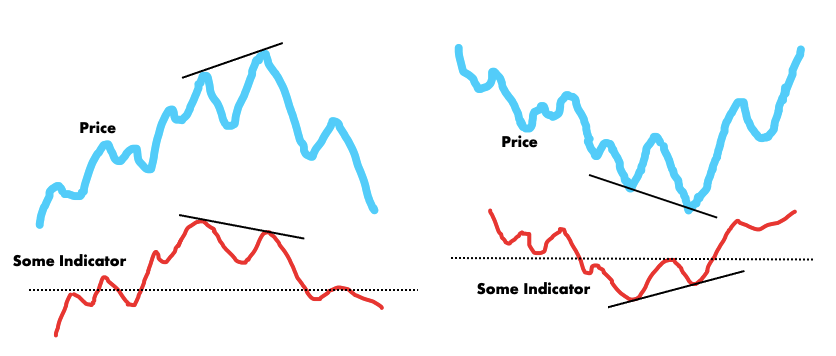
Consider a simple analogy to see why this is meaningful.
Let’s say you throw a stone in the air.
The stone will rise quickly at first, then slow down until it reaches a point of standstill before falling back to earth.
When the stone starts slowing down, you know that even though it is still rising, it will soon stop and fall.
This is self-evident because no item can stay in the air without the help of some type of force. Gravity will catch up with our stone as it loses momentum.
How does this relate to trading?
If the market is trending in any direction, but the strength of price movements is lessening, this could suggest that the trend will reverse or that a countertrend move will occur.
Indicators that measure the strength of price movements are referred to as momentum indicators.
The most popular momentum indicators are the RSI, MACD, and Stochastic Oscillator. They basically show the same thing; the choice you must make is which one is easier to interpret.
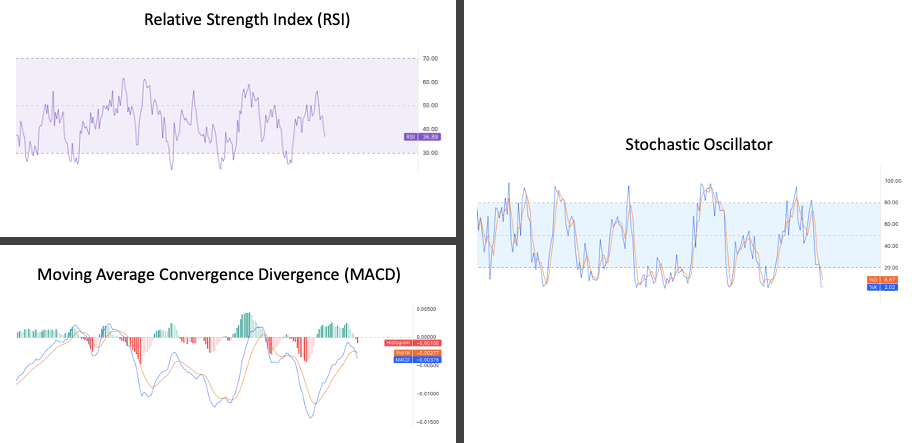
So, when people talk about divergence in technical analysis, they usually mean divergence between momentum and the price.
For example, you might see that the price is falling while the volume is increasing. This could imply that a large number of people are selling, and the price will soon reach a bottom.
In this guide, we focus on the general application of divergences, specifically those between price and momentum indicators.
Regular Divergences and Hidden Divergences
Divergences come in two types: regular divergences and hidden divergences. These are then further classified into bullish or bearish divergences.

When traders say that something is bullish, they believe that it causes the price to rise. When they say that something is bearish, it is the other way around.
Let’s take a closer look at how it works with divergences.
Regular Divergences
A regular bullish divergence occurs when the price makes a lower low, but the indicator makes a higher low.
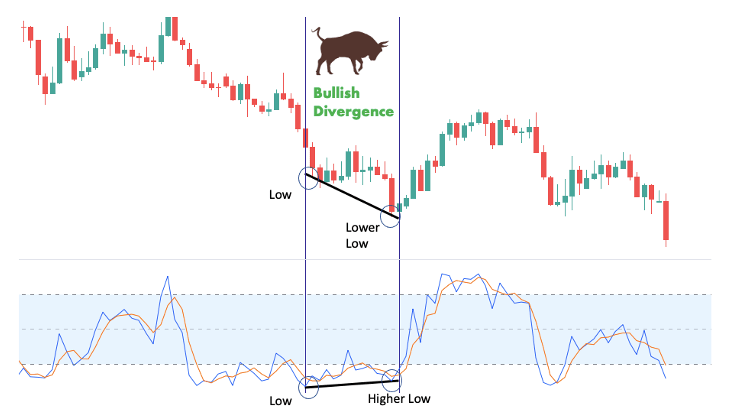
This could happen if prices are declining but more slowly than before. Therefore, the regular bullish divergence foreshadows the beginning of an upward correction or a trend reversal.
A regular bearish divergence is the opposite. It occurs when the price makes a higher high, but the indicator makes a lower high.
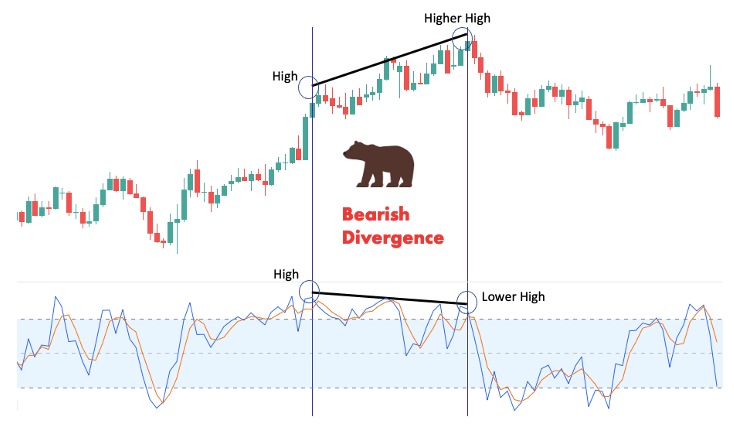
In other words, the market is still rising, but at a slower pace than before.
Remember the stone toss example from the beginning of this guide? When the stone slows in the air, you know the drop is close.
While there is no gravity that will force the price to fall if the uptrend slows, it can happen frequently enough to make for profitable trades.
Now, what about hidden divergences?
Hidden Divergences
Many people are confused by this, but hidden divergences are not difficult.
They occur in trending markets when prices consolidate but don’t break the trend’s structure.
Recall that:
- uptrends are defined by higher highs and higher lows
- downtrends are defined by lower lows and lower highs
A hidden bullish divergence occurs when the price makes a higher low, but the indicator makes a lower low.
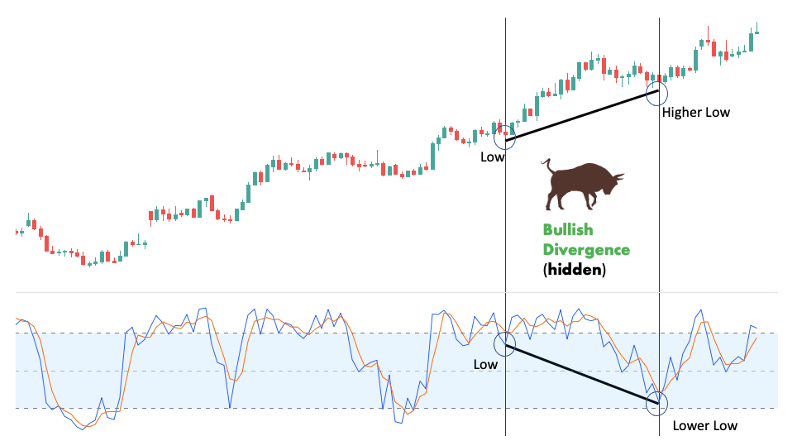
The consolidation shows you that sellers attempted to revert the trend, but despite the bearish momentum, they were unable to push the price below its previous low.
This is a bullish sign!
It’s “hidden” because the indicator is rather bearish, but when the situation is taken as a whole, the odds favor an upswing.
The hidden bullish divergence can be an excellent opportunity to enter the uptrend.
The hidden bearish divergence works similarly. The price makes a lower high, but the indicator makes a higher high.
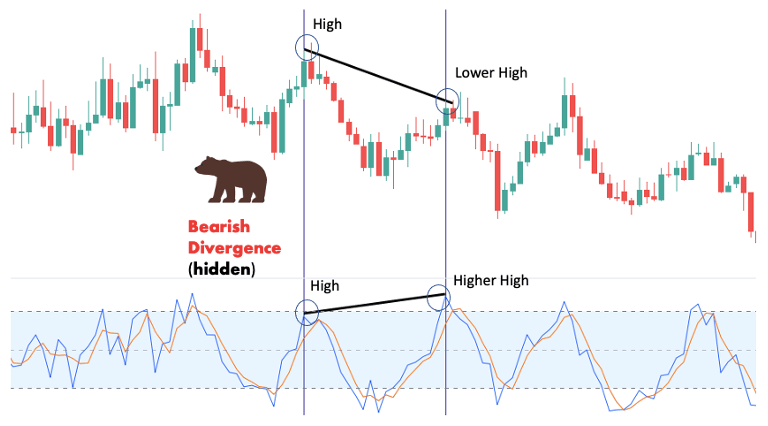
Despite the bullish momentum, the market could not close above its prior high. As a result, we have another lower high, which fits perfectly in the downtrend.
That’s why traders prepare for further weakness once a hidden bearish divergence emerges.
How to Find Divergences Easily
We know how tough it can be to find divergences, so we want to make your job easier by highlighting a few things that can help you remember what to look for.
In an uptrend, you’d expect to see rising values, right?
That is why you must compare the price highs to the highs of the indicator. A bearish divergence occurs when the indicator does not reach a higher high, while the price does.
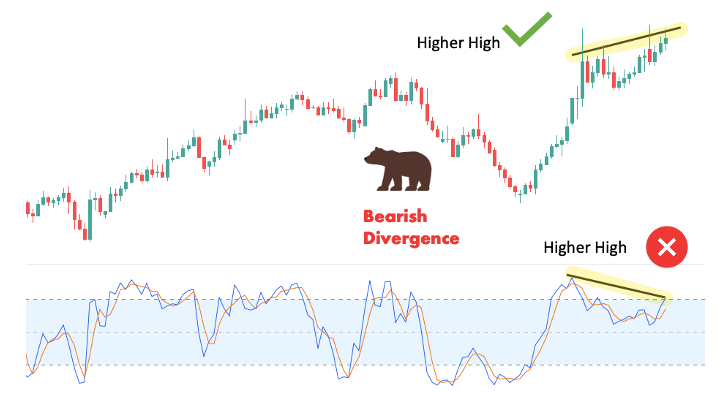
Recall that uptrends don’t only have higher highs. They also have higher lows.
So, you must also compare the lows of the price to the lows of the indicator. This will reveal any hidden bullish divergences.
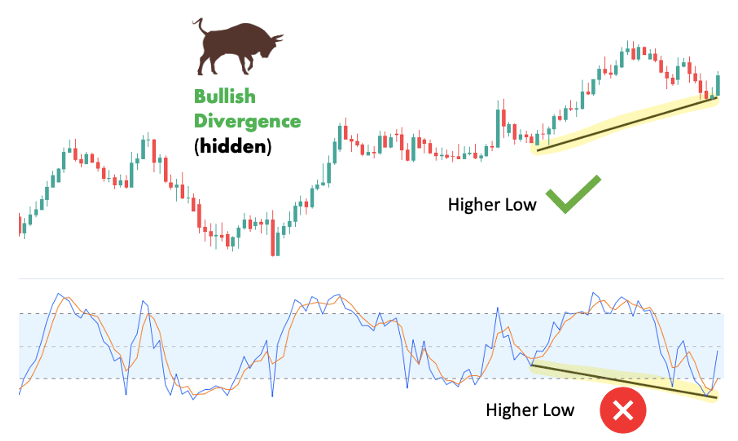
Now, the situation is the opposite in a downtrend: You’re looking for falling values.
That is why you must compare the price lows to the lows of the indicator. A bullish divergence occurs when the indicator does not reach a lower low, while the price does.
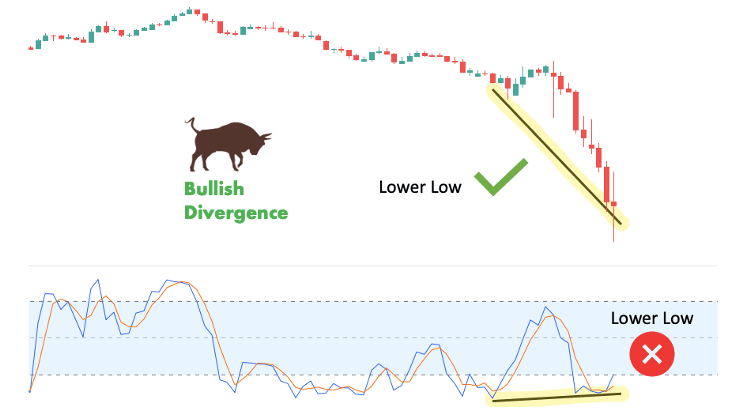
Besides lower lows, downtrends also have lower highs.
So, you must also compare the highs of the price to the highs of the indicator. This will reveal any hidden bearish divergences.
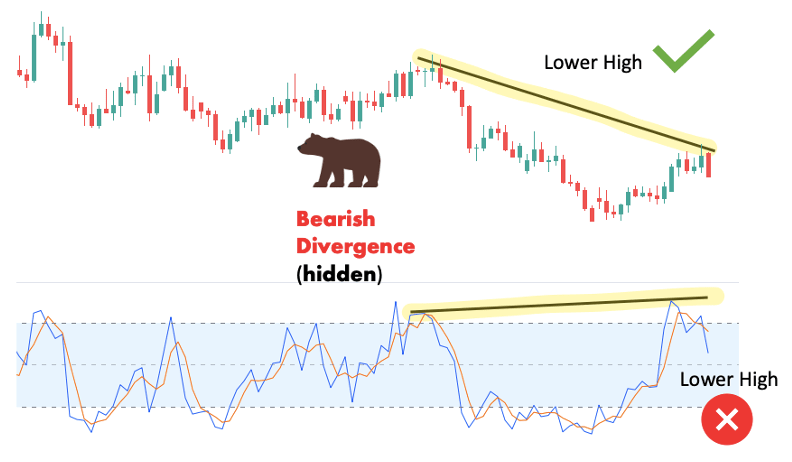
Divergence Cheat Sheet Table
Divergence | Forms when… | Meaning | Appearance |
Regular Bullish | The price makes a lower low, but the indicator makes a higher low | The price is falling, but bulls are getting stronger | |
Regular Bearish | The price makes a higher high, but the indicator makes a lower high | The price is rising, but bears are getting stronger | |
Hidden Bullish | The price makes a higher low, but the indicator makes a lower low | Sellers tried to reverse the uptrend, but they failed | |
Hidden Bearish | The price makes a lower high, but the indicator makes a higher high | Buyers tried to reverse the downtrend, but they failed |
How Does Divergence Work? – A Closer Look at Divergences
This will be slightly more advanced. You can skip this section while still learning to trade divergences from the remainder of the article.
We’ll use two popular indicators, the RSI and MACD, to demonstrate how divergence works.
The goal is to help you understand the concept. You’ll see the same types of divergences that we discussed earlier, so this is a good time to review them and practice finding them on the chart.
RSI divergence
RSI stands for “relative strength index” and it’s a very popular technical indicator. People use it to find situations in which the market might be overbought or oversold.
The RSI will rise as the number and size of up days increase and fall as the number and size of down days increase.
(Read more about how the RSI works here)
That’s why, in an uptrend, the RSI usually rises, and in a downtrend, the RSI usually falls. Divergence occurs when the indicator and the price are not in agreement.
Assume that the price is still rising, but that down days become more significant. The RSI might then begin to decrease, and you will notice what is known as a bearish divergence between the price and the RSI.
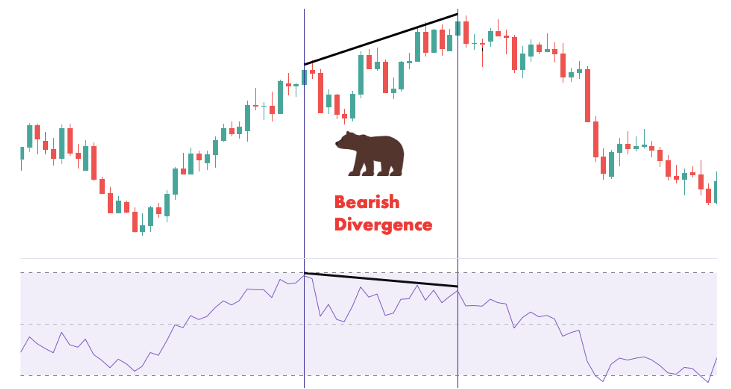
A bearish divergence indicates that the uptrend might be coming to an end.
This is because, although the market is still rising, the corrections are becoming stronger, which could indicate that sellers are gaining strength.
Now, consider the opposite case, in which prices are declining, but up days are becoming more prominent. This can lead to a bullish divergence between the price and the RSI.
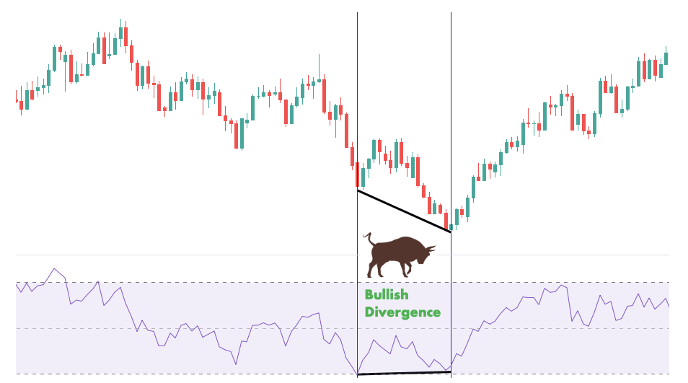
The implication is that the downtrend might be coming to an end.
You already know that divergences do not always signal a (possible) trend reversal. They can sometimes indicate the continuation of a trend. These are known as hidden divergences.
Consider the following situation:
The overall trend is downward, but the market has been slowly rising recently. It appears to have peaked, setting a lower high, and is now poised to fall again.
In this case, for a divergence to happen, the RSI must show a higher high. If the RSI shows a higher high while the market shows a lower high you get what’s called a hidden bearish divergence.
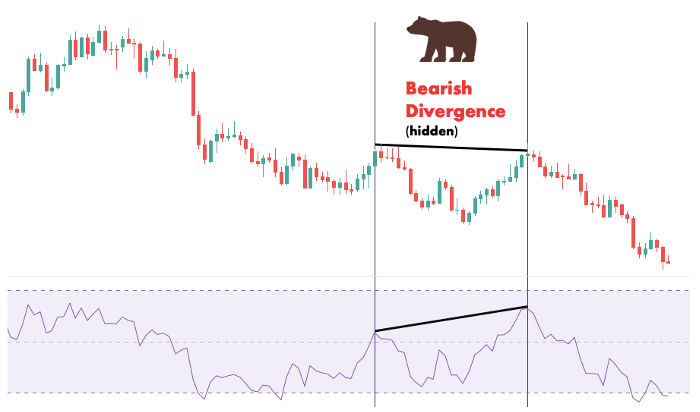
The RSI doesn’t reach a new high until the upswing has gained momentum. If the market was unable to make a higher high despite a fairly strong upswing, the decline is likely to continue.
That’s why the hidden bearish divergence signals the continuation of the downtrend.
There’s a similar logic to the hidden bullish divergence. The uptrend consolidates and makes a higher low, but the RSI makes a lower low.
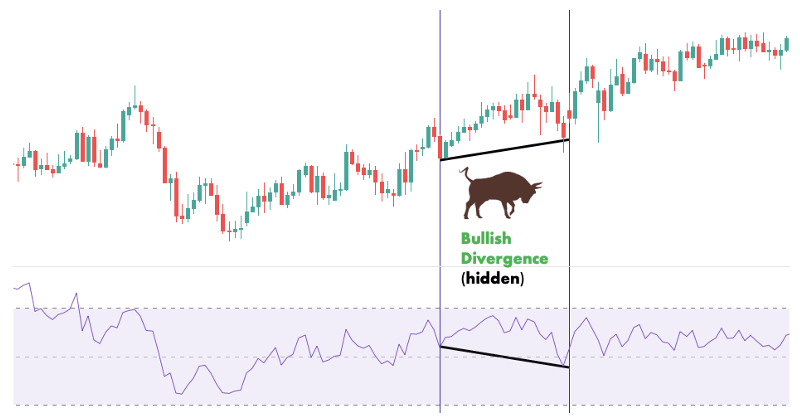
So, despite their best efforts, sellers could not break the pattern of the uptrend, signaling that buyers remain in control and the road is clear for the next up leg.
MACD Divergence
The moving average convergence divergence (MACD) is a trend-following indicator that shows the relationship between two moving averages.
Here’s what it looks like:

To better understand how MACD divergence works, let’s complete a quick exercise that has nothing to do with the MACD, but will help put things in perspective.
You have the following prices:
100, 200, 300, 400, 450, 470, 480, 483
Obviously, they rise, but as you move from left to right, the difference from one price to another gets smaller. Traders refer to this as a loss of momentum.
This is also visible if you look at the same prices on a chart:
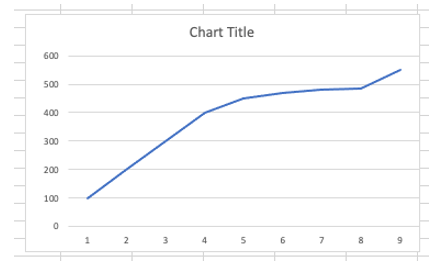
The line quickly rises at first, then it smoothes out.
Remember that one of the key ideas of divergence trading is finding situations where the momentum does not confirm the trend.
This is exactly what happens here.
Prices are rising, but the rate at which they are rising is slowing. While this is visible if you look closely, it is usually easier to visualize the momentum separately and compare it to the price.
That way, any divergences are immediately apparent.
So, let’s plot the momentum and the price next to each other to highlight the divergence.
To do so, first smooth out the price changes by calculating a two-period moving average (100+200/2 = 150, 200+300/2 = 250, and so on).
Then, below the prices, plot a chart comparing one moving average period to the next. This second chart depicts the changes in momentum.
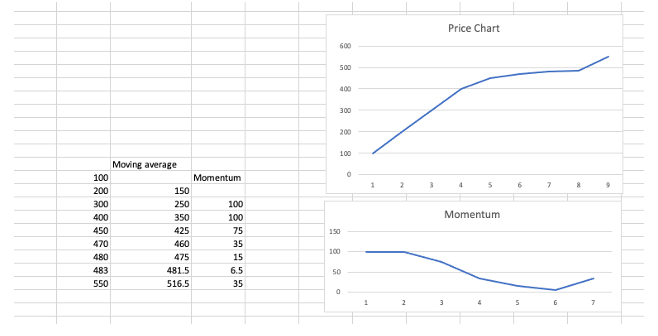
The difference between 150 and 250 is 100, and the difference between 350 and 250 is 100 again (no change in momentum). However, between 425 and 350, the difference is 75 (momentum has started to slow down).
You can easily see the bearish divergence by comparing the price chart to your makeshift momentum indicator.
MACD divergence works similarly, butthe indicator itself is more complicated, so we won’t go into the calculation here. Instead, let’s see what the different types of divergences look like with the MACD.
First, there’s the classic bearish divergence, which is caused by rising prices but falling momentum. This is the same as what we have seen above.
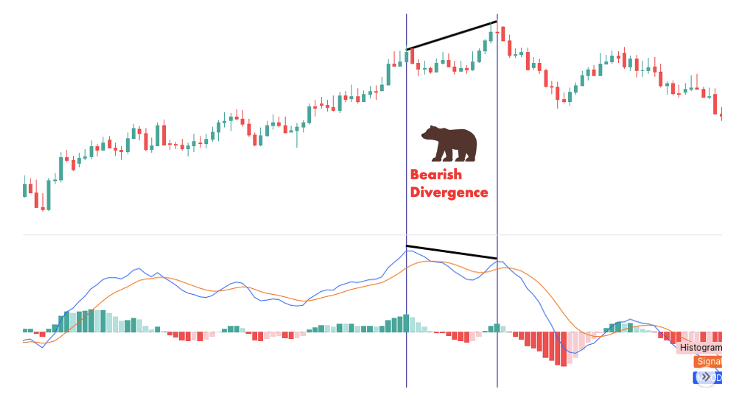
Then there’s the bullish divergence, which occurs when the price is falling, but the bullish momentum is increasing.
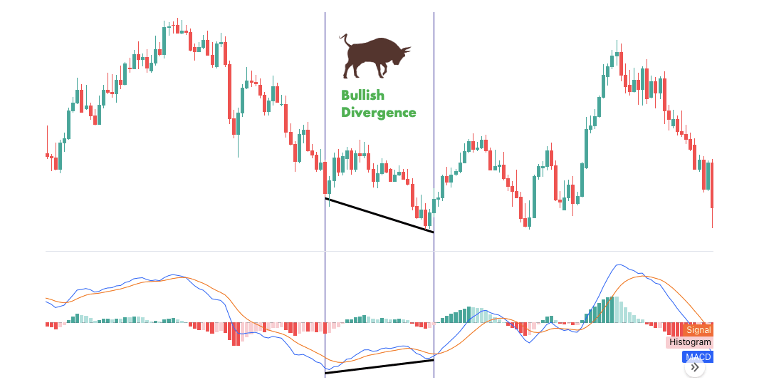
And, finally, there are the hidden divergences.
The hidden bearish divergence occurs when the price does not form a higher high despite strong bullish momentum.
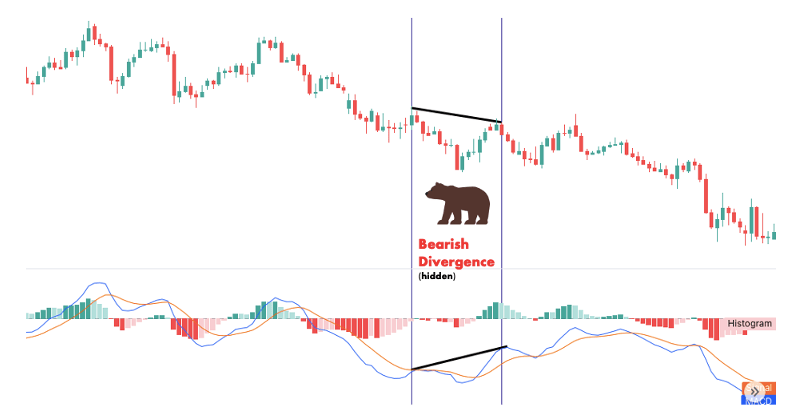
Conversely, the hidden bullish divergence occurs when the price does not form a lower low despite strong bearish momentum.
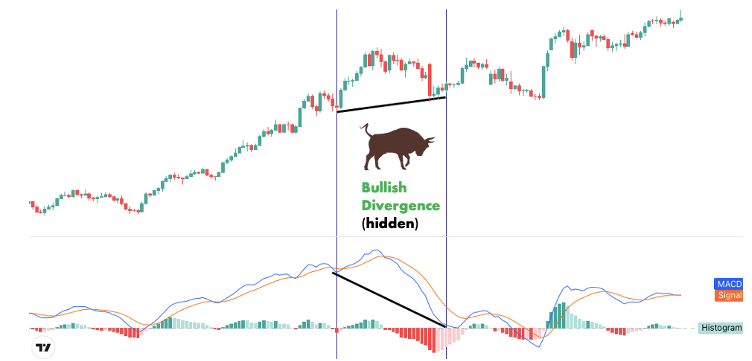
This content belongs to ForexSpringBoard.com DO NOT COPY
How to Trade Divergence
Now that you understand what divergences are, let’s look at how to trade them.
There is no one proper way to do it, but there are several options depending on your trading style.
Here, we’ll look at some examples to teach you the fundamentals. You can use these ideas to make whatever trading strategy you wish.
Regular Bullish Divergence Trade Example
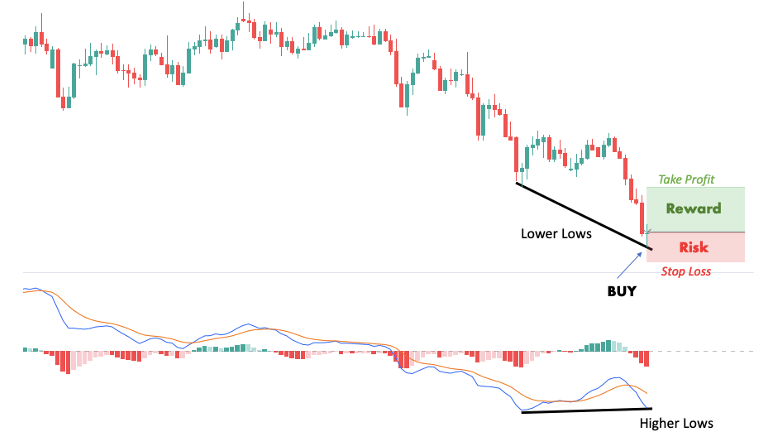
In the above example, the goal is to benefit from the correction; we don’t expect a market reversal.
You can see that the market has dropped significantly and set a new low, while the indicator has simultaneously created a higher low.
Because the down move is quite large, there is already a good chance for a correction. Combine this with the bullish divergence and you have a nice trading opportunity.
We enter with a long position when the current candle closes, with our stop loss below the recent low and our profit target around 1.5x the risked amount.
The further out you place the stop loss, the more likely you are to catch the correction. So, by lowering the risk-reward ratio, you can boost your chances of winning.
This is something to think about if you’d rather have a lot of minor wins rather than a few big ones.
Regular Bearish Divergence Trade Example
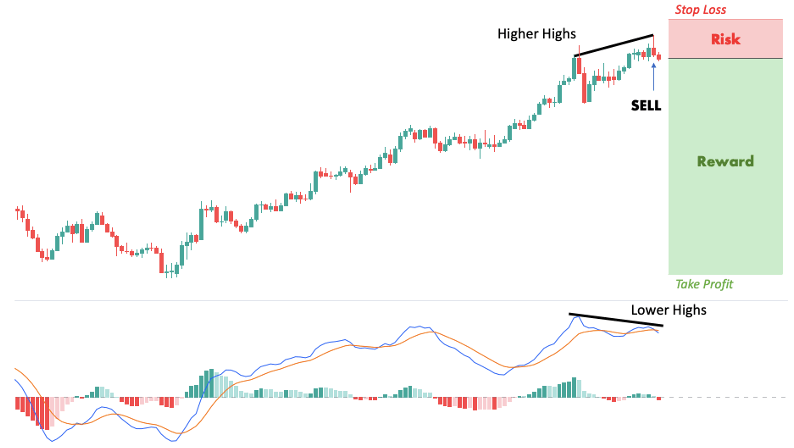
Let’s try something different. We are no longer looking for a correction; rather, we are looking for a trend reversal.
The situation is also different in that the market is heading up, so we’ll enter the market with a short position and bet on a decline.
We’ll enter when the market makes a higher high, but our indicator produces a lower high. The price also forms a hammer candlestick, which is a famous reversal candlestick pattern.
So, with a bearish divergence and a hammer, we decide to take action. The stop loss goes above the most recent high, and our profit target is set to the beginning of the uptrend.
If you use a similar trading strategy, you’ll have many smaller losses and an occasional home run.
Hidden Bullish Divergence Trade Example
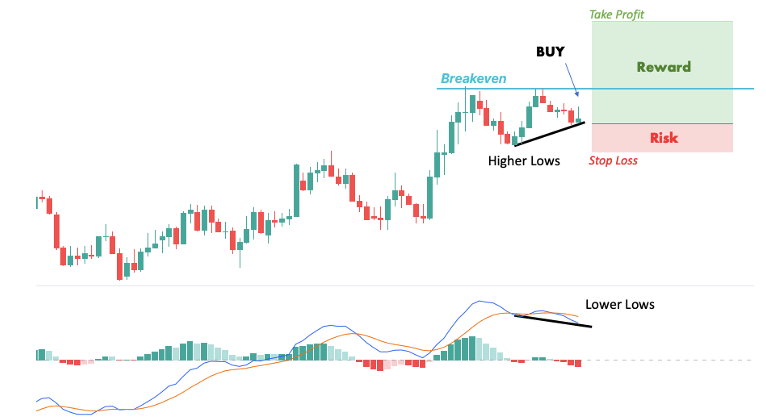
The previous two examples involved trading against the trend, so it’s time to look at examples of following the trend.
The above example illustrates a trade scenario in which we use the hidden bullish divergence as a buy signal in an uptrend.
We are concerned primarily with the divergence in this case; therefore, we open a trade even though the bullish candlestick is quite weak.
The stop loss is set below the recent swing low, so even if the consolidation continues, we have some time before losing the trade. The take profit is at about 5x the risked amount.
Notice that we also establish a breakeven level. This means that if the market reaches this price, we will move the stop loss to the entry price.
This creates a third possibility: Instead of winning or losing, we can end up with no gain or loss on the trade.
Hidden Bearish Divergence Trade Example
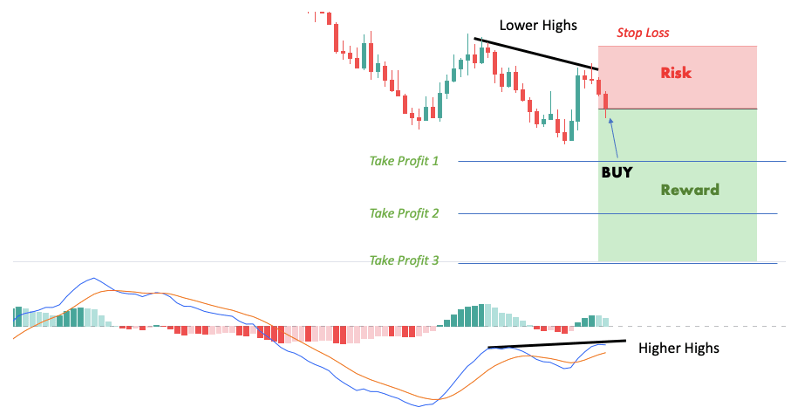
In this last example, the bullish consolidation appears to have peaked out and the market is now in the process of erasing the small gain.
After seeing the hidden bearish divergence, we expect prices to drop even more, so we open a short position at the close of the candlestick shown by the arrow.
The stop placement is probably not surprising; it is above the most recent lower high. Notice, however, that this time we have three profit objectives.When the market reaches the first profit target, we will close one-third of the position. When it reaches the second profit target, we close another third of the position. Finally, we close the entire trade when the market reaches the final profit target.
The benefit of doing this is that we will continue to profit while the market is trending in our favor. So, even if the trend reverses before we reach our final target, we will have made some money.
Advanced Divergence Trading Technique
One advanced divergence trading technique is to look for divergence on a higher timeframe and then trade it on a lower timeframe if the lower timeframe is showing a trend in the direction of the divergence.
Let’s say you notice a bullish divergence on the 4-hour chart. This happens when the market is in a downtrend, but the indicator is pointing up.

Because the bullish divergence indicates a possible upswing, you might want to buy the currency pair.
Instead of placing the order on the 4-hour chart, you would drop down to the 5-minute chart, for example, and wait until it begins trending upward.
Then you would buy on a pullback using the 5-minute chart.
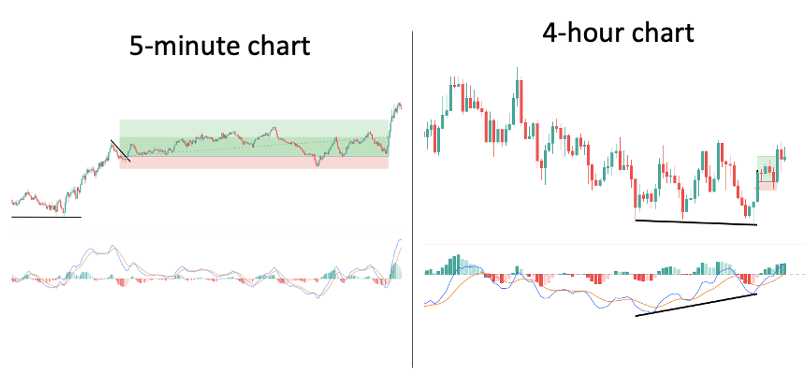
This approach has the advantage of allowing for a tight stop, but you are trading against the wider trend, so keep your risk in check.
Which Indicator Is Best for Divergence Trading?
There is no such thing as the best indicator for divergence trading, as it is all very personal. Some of the divergence indicators that have stood the test of time (in no particular order) are:
- Moving Average Convergence Divergence (MACD)
- Relative Strength Index (RSI)
- Stochastic Oscillator
- COT Positioning
- Commodity Channel Index (CCI)
The COT (Commitment of Traders) indicator is unique in that, unlike other price-based indicators, it is a sentiment indicator displaying how large traders are positioned in the futures market.
The COT report is released every Friday and is an excellent tool when you are looking for divergences.
For instance, if the price is falling, but you see on the COT report that large speculators are accumulating long positions, you know that something is up.
Frequently Asked Questions
A divergence in trading occurs when the price and the indicator are pointing in opposite directions. For example, the price is rising, and the indicator is falling or vice versa.
Look for price highs in an uptrend and compare them to the indicator highs. If the indicator does not match the rising highs, you might want to bet against the trend. Do the same in a downtrend, but compare the lows.
Most traders prefer momentum indicators to find divergences. There are many momentum indicators to choose from, but the most popular are the MACD, RSI, and Stochastic Oscillator.
The best timeframe is the one that corresponds to your trading style. Don’t change your trading style in response to the divergence. Always search for divergences on the timeframe you normally use.
Conclusion
You should now have a much better understanding of divergences. Of course, being skilled at finding them takes practice, so don’t be disheartened if you’re still confused at times.
There’s nothing wrong with revisiting this tutorial for a refresher or printing the summary tab of our Divergence Cheat Sheet and bringing it to your trading desk.
Be aware that divergence trading, like any other trading technique, has some drawbacks.
People often overlook the fact that a visual inspection of past chart data won’t reveal the failed divergences simply because they no longer appear as a divergence.
The thing is: Divergence trading suits some people quite well, and does not suit others.
If you like the idea, look into it further. Spend some time backtesting and developing a strategy that you enjoy.

